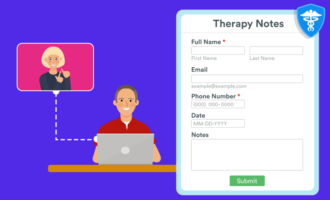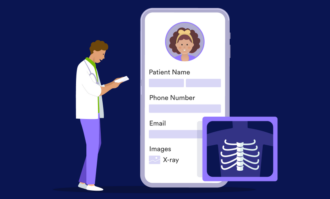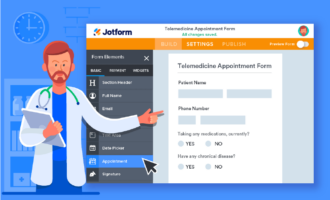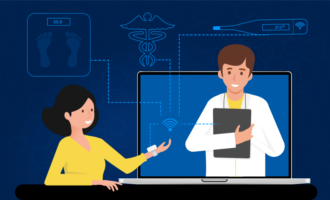Due in large part to the coronavirus epidemic and many cities implementing shelter-in-place orders, telehealth and teletherapy services have seen a surge in use. But while these services are growing in popularity, many people are asking, What is teletherapy, and how does it work?
Teletherapy is exactly what it sounds like — therapeutic services a provider delivers to a patient using virtual technology like video conferencing. This can include mental health services as well as speech and occupational therapy — all of which are in great demand.
Just so you know
You’ve got your medical toolkit ready to help those in need — but what about your telemedicine toolkit? With Jotform’s HIPAA-friendly telehealth platform, you can easily create online medical forms that keep sensitive health data safe.
About 3.5 million American children require speech, occupational, or mental health therapy. In addition, more than 43 million U.S. adults experience mental illness in a given year, and a whopping 56 percent of Americans who have a mental health condition don’t get adequate treatment for a variety of reasons, one of them being a shortage of mental health practitioners.
That’s where teletherapy can help — but how does it work?
Teletherapy basics
If you’ve ever used video calling on your cell phone, then you know how live video works. It’s the same concept with teletherapy, only between a doctor and a patient. Teletherapy sessions are just like face-to-face sessions, except that instead of seeing each other in person, you’re on a two-way video call.
Using a secure platform, clinicians connect with clients virtually and converse just as they would in an in-person session. Each virtual session is private, and clinicians are required to use approved software that complies with the HIPAA Privacy Rule, which ensures the data is private and secure and that all medical information is safeguarded, including therapy session notes.
The benefits of teletherapy
Along with the fact that teletherapy is just about equally effective as in-person sessions, there are some benefits unique to a virtual environment.
Greater accessibility
If you live in a rural community or have a disability that makes traveling difficult — or if you’re even just unsure about meeting with someone in person for the first time — teletherapy can be beneficial. Because it can be done from your living room, things like driving to your appointment in bad weather or leaving the house when you’re physically compromised are no longer barriers to critical treatment.
Flexibility
Many people are overworked and overcommitted, and it can be hard to schedule a therapy session during limited office hours. When a therapist is available at a time that’s more convenient for the patient, it offers greater flexibility and allows more people to get the support they need, when they need it. For example, a patient with high anxiety that is otherwise well-managed could more easily secure an emergency check-in, which could prove to be invaluable.
Reduced wait times
Along with increased flexibility is the fact that patients don’t have to sit in a waiting room, and they can often get an appointment sooner than if they were going into the office.
Instead of taking time off from work to battle traffic, sitting in a waiting room, having the session, and then battling traffic to return to work or go home, they can simply go to a private room, turn on the computer, and engage with a clinician — a much more appealing and viable option for many.
Safety
Along with physical safety — no driving in dangerous conditions, for example — there’s also a sense of emotional safety. Many people experience anxiety when sitting in the waiting room of a doctor’s office, and going into a new environment to meet a new clinician can be a stressful experience. With teletherapy, patients can familiarize themselves with this new process from a more familiar — and comfortable — environment.
HIPAA-friendly teletherapy platforms
Because all software used for teletherapy must be HIPAA-friendly, platforms like FaceTime and Skype aren’t suitable solutions. Fortunately, there are a variety of other options for clinicians to consider, including Doxy.me, Thera-link, WeCounsel, and VSee. Choose a platform that’s easy for both you and your clients to use and that gives you the most benefits for your teletherapy practice.
Just so you know
If your organization is fighting against COVID-19, you can apply for a free, unlimited, HIPAA-friendly Jotform account with our Coronavirus Responder Program.
While teletherapy isn’t a one-size-fits-all option and isn’t suitable for everyone, there are myriad benefits to both the clinician and the patient that demonstrate just why it’s increasing so much in popularity. By choosing a platform that suits the needs of both parties, therapists can make their services available to an even greater population — even after the COVID-19 pandemic.
















































Send Comment: